 What if you were told that eating foods rich in Omega-3 or taking supplements of Omega-3 would guarantee that you would reap the following benefits:
What if you were told that eating foods rich in Omega-3 or taking supplements of Omega-3 would guarantee that you would reap the following benefits:
- Improved cardiovascular health, including protecting the heart from mental stress;
- Protection from Alzheimer’s Disease;
- Protection from vision loss, including aiding in dry-eye syndrome;
- Reduced risk of developing prostate cancer;
- Improved memory in healthy young adults;
- Reduced mental health problems (especially curbing behavioral problems in youngsters);
- Reduced seizure episodes in epileptic patients;
- Protection from post-partum depression in new mothers;
- Reduced symptoms of allergies and asthma;
- Reduced risk of psychosis; and
- Increased fetal cognitive and motor development.
Whew, that’s some list! So, should you run to the supermarket and stock up on all the tins of tuna, salmon and sardines at the store? Of course you would!
Unless of course you hate fish.
Below will be some suggestions for those fish haters, but in the meantime…
Enjoy fish
The secret to including a lot of Omega-3 in your diet if you do enjoy eating fish, is consuming a diet rich in fatty fish, also sometimes known as oily fish, especially the tissue of fatty fish such as trout, mackerel, tuna, herring, sardines, and salmon. Nutritionists and healthcare professions have determined that fish oils contain two main ingredients: DHA (docosahexaenoic acid), and EPA (eicosapentaenoic acid), which are both types of Omega-3 fatty acids. The filets of oily fish contain up to 30% fish oil, and are good sources of vitamins A and D, whereas white fish (a significantly less oily fish) stores its oil supply in the liver, thus they contain less oil and have much lower concentration of Vitamins A and D.
So how much fatty fish do you need to consume to receive the maximum benefits of Omega-3 fatty acids? Two or three times a week at least, and even more if you are so inclined.
You might remember taking cod liver oil supplements or cod liver malt as a child, but, while their contribution to your good health was admirable, there are still many differences between fish oils and cod liver oil. Fish oils are extracted from the tissue of deep sea oily fish such as tuna, mackerel, herring and salmon. Cod liver oil, by contrast, is extracted solely from the livers of cod. Fish oils contain higher amounts of omega-3 fatty acids than cod liver oil, but lower amounts of vitamins A and D.
Omega-3 foods
Not everyone likes the taste of fish, nor preparing it. Face it, unless you’re dining out and don’t have to deal with the preparation and smell involved with readying fresh fish for broiling, pan frying, etc., or even opening a tin of tuna which smell lingers long after you’ve consumed that tuna sandwich, you may not want to follow a diet that consists primarily of fish.
But wait!
If you are averse to eating seafood of any kind, you can indeed factor Omega-3 into your diet, by using supplements, or better still, you can also include foods like these listed below to add Omega-3 to your diet:
Omega-3 consumption
Vegans need not fret about choosing Omega-3 rich food. Their best option is Omega-3-enriched eggs (yolk and all), which have a natural form of DHA and EPA in them.

Nut and plant-based alternatives
Though the concentration and type of EPA and DHA found in fish or eggs is a lesser amount, there are a variety of plant-based options available.
For example, a number of nuts or seeds like flaxseed, rapeseed (canola) or walnuts or chia seeds are good alternatives, or, if you prefer veggies, ALA is found in some green vegetables, such as Brussels sprouts, kale, spinach, and salad greens.
Flaxseed are the richest source of ALA in our diets. By mixing just 1 tablespoon of flaxseed oil with food, or by adding 2 tablespoons of ground flaxseeds to your morning yogurt, oatmeal, or cereal, you can get 57 percent of your daily value of ALA.
Canola in your diet gives you 11 percent of the amount of ALA you need on a daily basis. A daily tablespoonful, though high in calories, will infuse this valuable
Walnuts, not just found in mom’s coffeecake, are beneficial for your health. A mere quarter-cup of walnuts provides 14 percent of the ALA you need every day, along with other nutrients such as manganese.
Chia seeds are very rich in Omega-3 nutrients. Sprinkle them over cereal or yogurt, or even mix them with your flour when baking.
Algae Spirulina is a dense source of Omega-3, and its powder can be added to water or juices.
Soybean or tofu works well too – just a tablespoon of soybean oil, or a cup of cooked soybeans, or a half-cup of tofu meets about 7 percent of your ALA needs for the day.
Mixed greens are more standard fare, plus they have the added plus of giving you an Omega-3 boost. Your best choices for a salad would be kale, spinach, or dark leafy greens – just one cup gives you 56 percent of your daily value.
Your daily health tip is to scoop up some of these great greens that are available in the Summer and load up on salad every chance you get. It’s good for you, and unlike fatty or sugary treats, this one looks good on you too.


